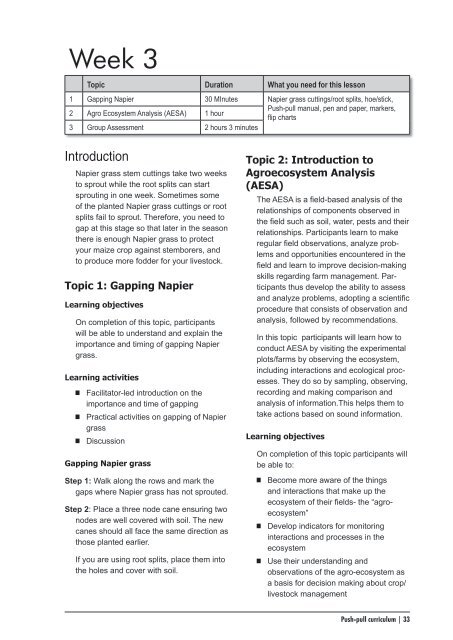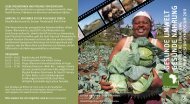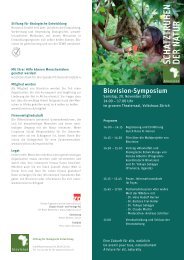Curriculum (PDF) - Biovision
Curriculum (PDF) - Biovision
Curriculum (PDF) - Biovision
Create successful ePaper yourself
Turn your PDF publications into a flip-book with our unique Google optimized e-Paper software.
Week 3<br />
Topic Duration What you need for this lesson<br />
1 Gapping Napier 30 MInutes Napier grass cuttings/root splits, hoe/stick,<br />
2 Agro Ecosystem Analysis (AESA) 1 hour<br />
Push-pull manual, pen and paper, markers,<br />
flip charts<br />
3 Group Assessment 2 hours 3 minutes<br />
Introduction<br />
Napier grass stem cuttings take two weeks<br />
to sprout while the root splits can start<br />
sprouting in one week. Sometimes some<br />
of the planted Napier grass cuttings or root<br />
splits fail to sprout. Therefore, you need to<br />
gap at this stage so that later in the season<br />
there is enough Napier grass to protect<br />
your maize crop against stemborers, and<br />
to produce more fodder for your livestock.<br />
Topic 1: Gapping Napier<br />
Learning objectives<br />
On completion of this topic, participants<br />
will be able to understand and explain the<br />
importance and timing of gapping Napier<br />
grass.<br />
Learning activities<br />
Facilitator-led introduction on the<br />
importance and time of gapping<br />
Practical activities on gapping of Napier<br />
grass<br />
Discussion<br />
Gapping Napier grass<br />
Step 1: Walk along the rows and mark the<br />
gaps where Napier grass has not sprouted.<br />
Step 2: Place a three node cane ensuring two<br />
nodes are well covered with soil. The new<br />
canes should all face the same direction as<br />
those planted earlier.<br />
If you are using root splits, place them into<br />
the holes and cover with soil.<br />
Topic 2: Introduction to<br />
Agroecosystem Analysis<br />
(AESA)<br />
The AESA is a field-based analysis of the<br />
relationships of components observed in<br />
the field such as soil, water, pests and their<br />
relationships. Participants learn to make<br />
regular field observations, analyze problems<br />
and opportunities encountered in the<br />
field and learn to improve decision-making<br />
skills regarding farm management. Participants<br />
thus develop the ability to assess<br />
and analyze problems, adopting a scientific<br />
procedure that consists of observation and<br />
analysis, followed by recommendations.<br />
In this topic participants will learn how to<br />
conduct AESA by visiting the experimental<br />
plots/farms by observing the ecosystem,<br />
including interactions and ecological processes.<br />
They do so by sampling, observing,<br />
recording and making comparison and<br />
analysis of information.This helps them to<br />
take actions based on sound information.<br />
Learning objectives<br />
On completion of this topic participants will<br />
be able to:<br />
Become more aware of the things<br />
and interactions that make up the<br />
ecosystem of their fields- the “agroecosystem”<br />
Develop indicators for monitoring<br />
interactions and processes in the<br />
ecosystem<br />
Use their understanding and<br />
observations of the agro-ecosystem as<br />
a basis for decision making about crop/<br />
livestock management<br />
Push-pull curriculum | 33




